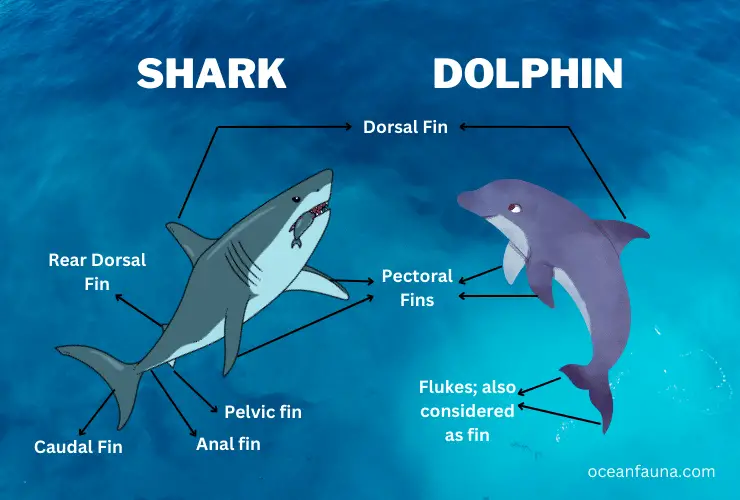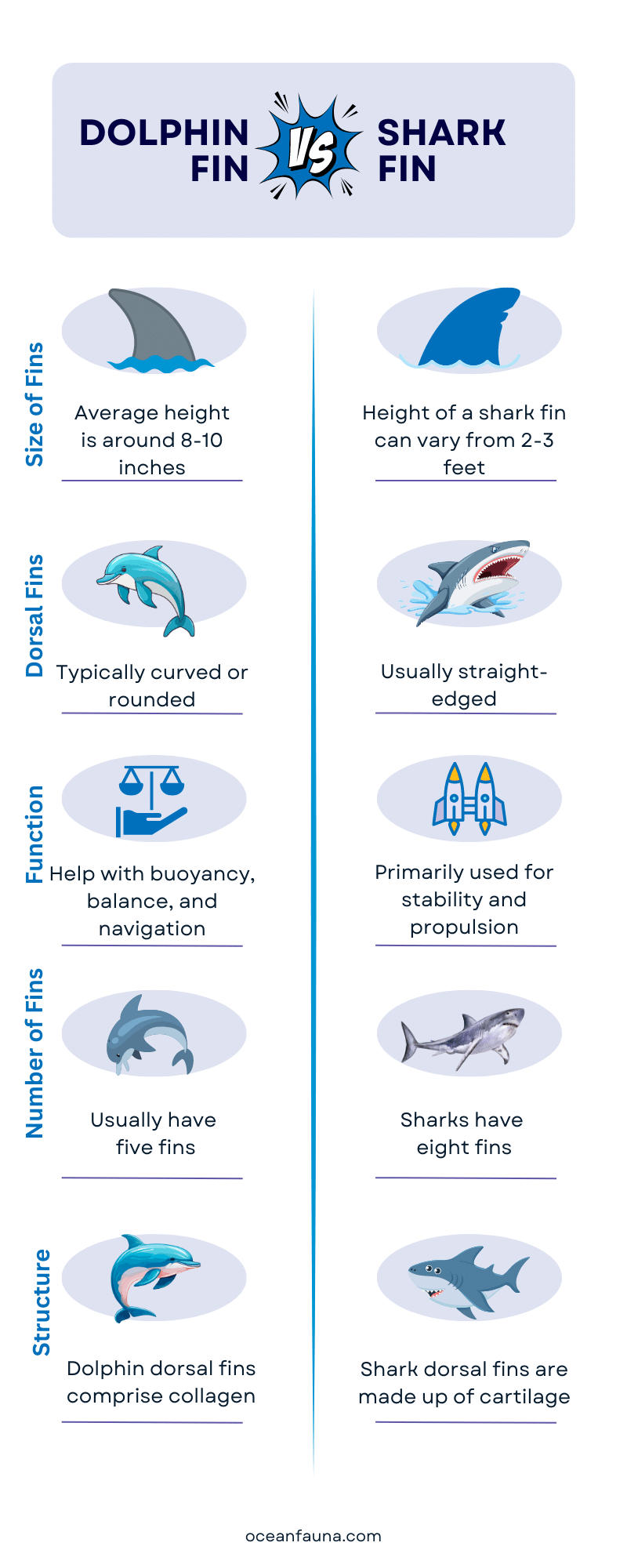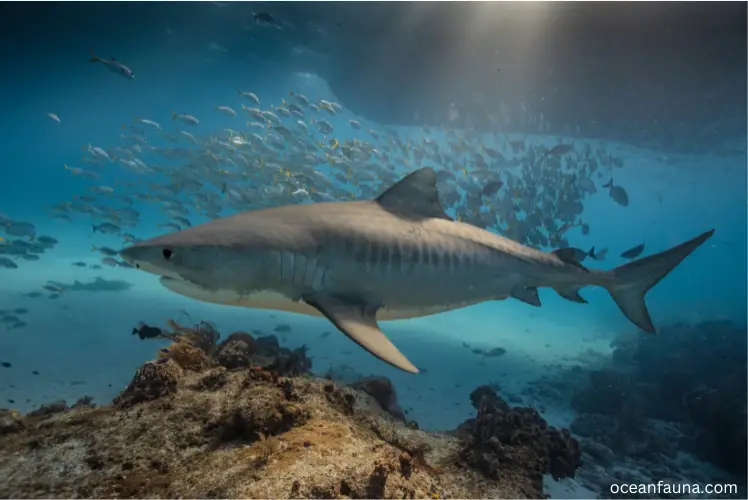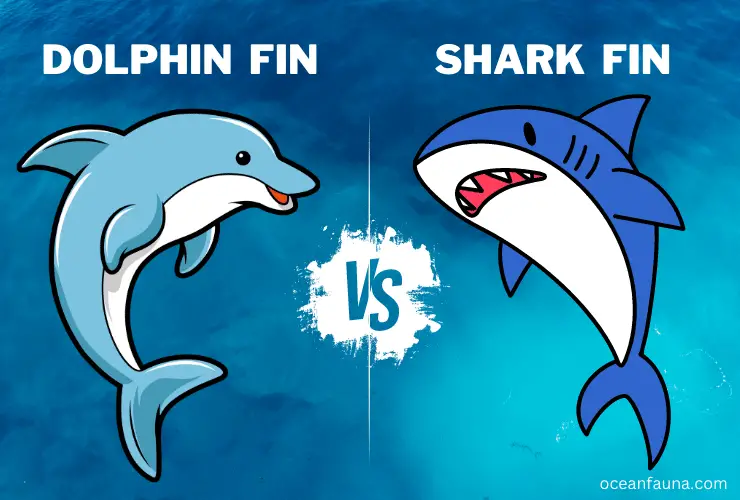While dolphins are mammals and sharks are fish, both of these ocean dwellers have fins. But you will be surprised to know their fins are not the same. There are so many differences between dolphin fins and shark fins.
In this article on dolphin fin vs shark fin, I will discuss how they differ in terms of shape, size, function and others. Here is a chart of the differences between dolphin fin and shark fin. Have a look.

| Aspect | Dolphin Fin | Shark Fin |
| Shape | Curved, sickle-shaped | Straight or slightly curved |
| Location | Dorsal (back) fin | Dorsal (back) fin |
| Size | Generally smaller and proportionate to body size | Varies in size, can be quite large and prominent |
| Structure | Made of dense connective tissue | Made of cartilage |
| Function | Stabilizes and assists in maneuvering and steering | Provides lift and stability during swimming |
| Movement | Moves vertically and horizontally | Moves mostly side to side |
| Flexibility | Moderately flexible | More rigid and less flexible |
| Sensory function | Not associated with sensory organs | Contains sensory organs called ampullae of Lorenzini |
| Secondary functions | May aid in social communication and displays | Can be used for heat regulation and as a mating or territorial tool |
Differences Between Dolphin Fin and Shark Fin
There are several differences between the dorsal fins of dolphins and sharks, which are described below.
Size
Dolphin fins are generally smaller than shark fins. The average height of a dolphin fin is around 8-10 inches, while the height of a shark fin can vary from 2-3 feet, depending on the species.
Shape
Dolphin dorsal fins are typically curved or rounded, whereas shark dorsal fins are usually straight-edged. While some shark species may have more rounded fins, they are still distinguishable from the rounded fins of a dolphin.
Movement
Dolphin dorsal fins are flexible and can move independently of the body, which helps them to maintain balance and make sharp turns. In contrast, shark dorsal fins are stiff and primarily serve to provide stability in the water.
Function
Dolphin dorsal fins help with buoyancy, balance, and navigation. They also play a role in communication as they contain a complex network of blood vessels and nerves connected to the brain. Shark dorsal fins are primarily used for stability and propulsion.
Structure
Dolphin dorsal fins comprise collagen, a fibrous protein that provides strength and flexibility. In contrast, shark dorsal fins are made up of cartilage, which is a more rigid and less flexible connective tissue.
Number of fins
Dolphins usually have five fins, including a dorsal fin located on their back that can vary in size depending on the species. It’s made up of fibrous connective tissue. On the other hand, sharks have eight fins: two pectoral fins, two pelvic fins, two dorsal fins, an anal fin, and a caudal fin. Pectoral fins are stiff and are used for downward movement, lift, and guidance.
Flexibility
Dolphin dorsal fins are highly flexible and can bend in multiple directions. In contrast, shark dorsal fins are relatively inflexible and can only bend slightly.
Visibility
Dolphin dorsal fins are located on the animal’s upper back and are visible from outside the water. Shark dorsal fins are typically only visible when the animal is swimming near the surface.

What Are the Uses of Fins For Sharks And Dolphins?
Fins play a crucial role in the lives of both sharks and dolphins. The fins of sharks consist of a range of different shapes and sizes, each serving a specific purpose. The first and second dorsal fins, located along the dorsal midline of the shark’s body, act as anti-roll stabilizing fins. These fins help maintain the shark’s balance and stability in the water and prevent it from rolling over.
The pectoral fins of dolphins, commonly referred to as flippers, are well-developed and situated behind the head and below the midline. These fins are crucial for steering and stopping, providing excellent paddles for stability and control while swimming. Dolphins possess a wide variety of flipper shapes, sizes and colours, depending on their specific species.
In sharks, both the caudal fin or tail fin and the pectoral fins play essential roles in providing lift and propulsion. The tail fin, also known as the heterocercal caudal fin, drives the shark through the water. Additionally, the pectoral fins of sharks act as wing-like paddles and are used for steering and guiding the shark through the water.
Both sharks and dolphins also possess other types of fins, such as the ventral or pelvic fins and the anal fins, which serve different purposes. The pelvic fins help the shark to turn and manoeuvre effectively, while the anal fin helps to stabilise the body and maintain balance.
Can Sharks and Dolphins Live Without Fins?

No, sharks and dolphins cannot live without their essential appendages. The fins of these animals play a vital role in their survival, and without them, they are unlikely to survive for very long.
Sharks, for instance, are characterised by their dorsal fins, pectoral fins, pelvic fins, anal fin, and caudal fins. The caudal fin, in particular, helps the shark to swim efficiently and propels the animal through the water. Without their fins, sharks cannot regulate their buoyancy, move through water, and, therefore, are unable to breathe in the manner required to survive.
They also suffer from significant blood loss and ultimately starve to death or are slowly eaten by other fish. Most drown because sharks need to keep moving to force water through their gills for oxygen. In fact, it is not uncommon to see sharks die in captivity due to their inability to swim properly and because the water is not effectively forced over their gills.
Similarly, dolphins need their tail or caudal fin in order to swim. No other part of their body can fulfil this function, so they depend on their tail fin. The tail fin is crucial as it propels them through water, allowing them to swim and hunt effectively. Without their rear fins, dolphins would essentially be paralyzed, unable to swim or survive.
However, according to some reports, dolphins can survive without dorsal fins. The northern right whale dolphins are the only species of dolphins found in the North Pacific Ocean that do not have dorsal fins.
Furthermore, sharks and dolphins have evolved to rely on their fins for other vital functions. For instance, sharks use their pectoral fins to steer and maintain their position in the water, while dolphins use flippers to turn and manoeuvre rapidly. These animals have adapted to their environment and developed specialised appendages that allow them to survive and thrive in their habitats.
What Are the Differences Between Collagen and Cartilage?

Collagen and cartilage are both crucial components of many types of connective tissues found in various animals, including dolphins and sharks. Collagen is a type of protein that is present in most connective tissues, including skin, bone, and cartilage.
On the other hand, cartilage is a type of connective tissue composed of mucopolysaccharides, protein substances, calcium, sulfur, and collagen.
One key difference between collagen and cartilage is their composition. While collagen is a protein, cartilage is a combined mixture of various substances. Collagen is an integral part of the extracellular matrix in connective tissues, providing strength and rigidity.
In contrast, cartilage provides cushioning and flexibility to joints, allowing for smooth movement and reducing the impact of mechanical stresses.
Another essential difference between collagen and cartilage is their role in different types of animals. For example, a dolphin’s fin is made up of collagen, which gives it its characteristic strength and flexibility.
The collagen in dolphin fins is arranged in a complex and organised manner, giving the fins unique physical properties. On the other hand, sharks’ fins are primarily made up of cartilage, providing them with the necessary cushioning to swim through water.
FAQs
Do dolphins or sharks have curved fins?
Dolphins and sharks have distinctively different fins, with each species having unique characteristics. In terms of dorsal fins, the curvature of the trailing edge provides a clear distinguishing feature between the two. Dolphins and porpoises have a highly curved trailing edge dorsal fin, while sharks possess a much straighter dorsal fin.
Dolphin fins are adapted for agility and speed in the water, with the curvature of their dorsal fin allowing for quick and precise movements. Conversely, the vertical orientation of shark fins helps them maintain buoyancy and stability while swimming. The straighter trailing edge of their dorsal fin also provides enhanced hydrodynamics, allowing sharks to move efficiently through the water.
While the curvature of the dorsal fin can be used as an indicator, it is not 100% accurate in identifying the species. Other factors, such as the shape and placement of the tail fin, can also help distinguish between a dolphin and a shark. For example, the tail fins of sharks are typically vertical and can sometimes break the surface just behind the dorsal fin, while dolphin tails tend to be horizontal and more rounded.
What are shark fins and dolphin fins analogous?
Shark fins and dolphin fins are analogous structures. Analogous structures have similar functions but evolved independently due to similar environmental pressures and selective forces.
In the case of sharks and dolphins, they both share a common adaptation of having streamlined bodies, dorsal fins and flippers, making them agile swimmers that can move quickly and efficiently through the water.
Sharks and dolphins are both aquatic animals that occupy similar niches in the ocean. They both have to navigate through water, hunt for prey, and avoid predators. Thus, they both have evolved similar adaptations that allow them to survive in their environment.
The dorsal fins of sharks and dolphins help reduce drag and provide stability while swimming. Additionally, both species have pectoral fins or flippers on their sides, but the shape and structure differ.
Shark fins are elongated and consist of a single bone covered in a layer of skin. They do not have any muscles or other tissues and are primarily used for stabilizing the shark while swimming. In some sharks, their dorsal fins also serve as hydrofoil, allowing them to generate lift and decrease the energy they need to swim.
On the other hand, dolphin fins are much more flexible and consist of a complex set of muscles, bones, and connective tissues. These structures allow for greater mobility and control of the dolphin’s movement in the water.
Conclusion
Now you have a clear idea of dolphin fin vs shark fin. Dolphins’ fins are made of collagen, and sharks’ fins are made of cartilage. If you want to know more about them, check out our other articles on dolphins and sharks. Also, keep your question in a comment. I will answer them as soon as possible.


1 thought on “Dolphin Fin Vs Shark Fin [Differences Explained]”